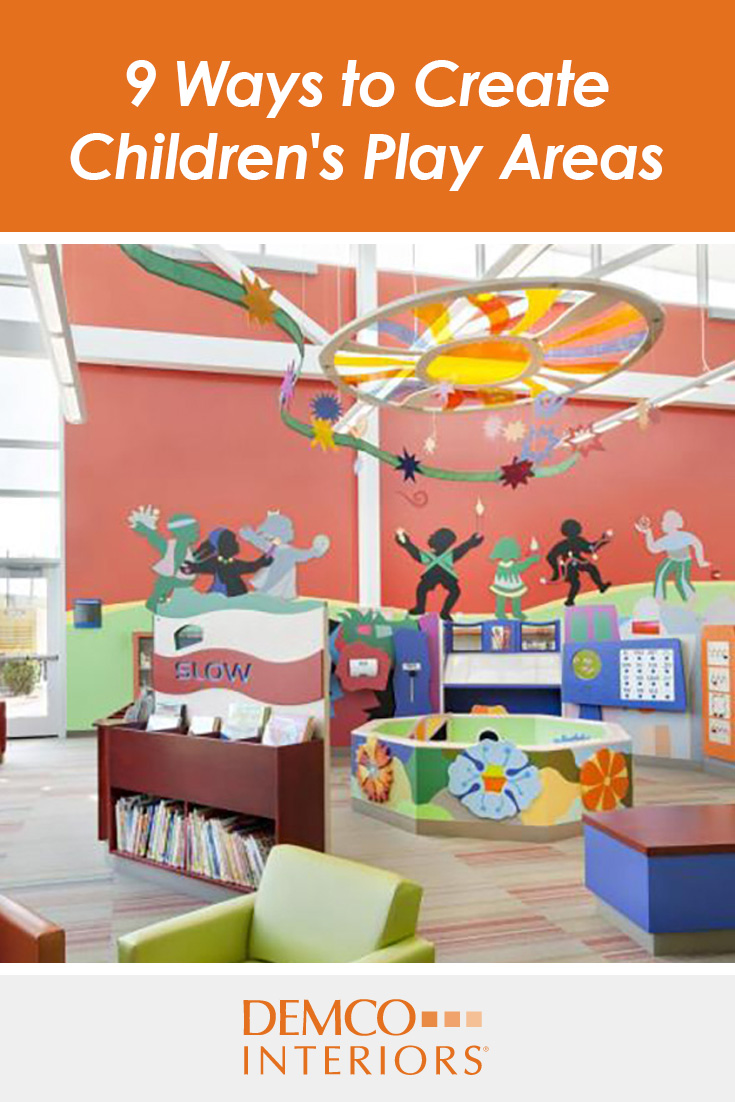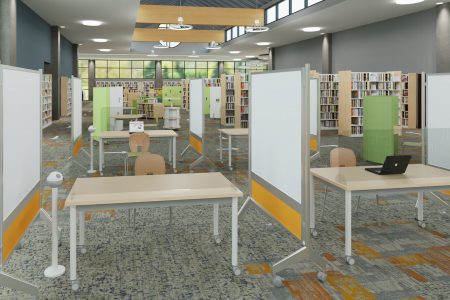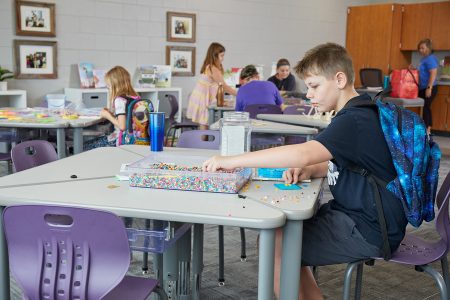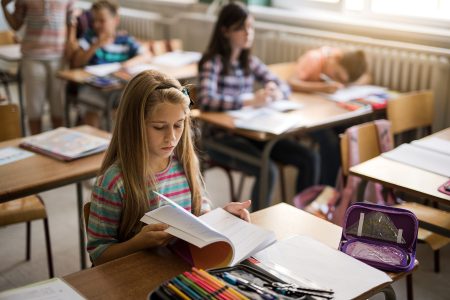 At HBM Architects, we’ve worked on many libraries, ranging from brand-new buildings to small, light renovations. Many libraries are incorporating early literacy elements in their children’s areas to encourage children to begin their journey toward becoming lifelong readers. There are several factors to consider when creating a successful interactive area that attracts children’s interest.
At HBM Architects, we’ve worked on many libraries, ranging from brand-new buildings to small, light renovations. Many libraries are incorporating early literacy elements in their children’s areas to encourage children to begin their journey toward becoming lifelong readers. There are several factors to consider when creating a successful interactive area that attracts children’s interest.
Design Questions to Consider
Are you looking to design or update an area of your library and want to incorporate children’s interactives, manipulatives and early literacy elements? Here are some questions you should ask:
- How are the interactives displayed?
- Is there enough room for children to engage with the elements?
- Does it require effort to manipulate or understand the elements?
- Are the elements organized in a way that children can understand and differentiate between activities?
- Is there a balance of technology and hands-on (low-tech) interactives?
- Does the space have supporting aesthetics for your components?
9 Engaging Elements for Your Children’s Area
We’ve found that the following features have worked well in our children’s library projects.
1. Crawler Area
If you are fortunate to have enough floor space for a crawler area, these are a great tool for the youngest of children. There are several approaches to creating an area for those too young to walk.
- Padded floor cushions are helpful. They are available in various colors, shapes and contours.
- Partially or fully enclosed low-walled areas work well with some benches or stools for parents to perch. Pay attention to sightlines for staff.
- For larger areas, having something to crawl through or over can be fun. Consider additional movable padded shapes.
- Tactile objects or various wall textures, shapes and colors are important at crawler height. Mirrored areas won’t go unnoticed either. Durability is also key to these spaces, as most small children want to chew on whatever they can.
2. Interactive, Hands-on Elements
Light boxes, LEGO® tables, train tables and puzzles are great for active little ones to engage with their hands. Large 3-D geometric shapes, building blocks and magnetic blocks are especially fun to build and knock down. They keep children’s interest, as they involve imagination and kids can create something different every time. Keeping the pieces organized and displayed properly can be a challenge for staff, but children will also like to take part in sorting and placing them in the correct bins when it’s time for cleanup.
Magnetic boards have been very popular. The boards are simple, cleanable surfaces (of any color and shape) that can accept many different types of objects. Anything magnetic can be applied — shapes, letters, numbers and pictures — all of which can appeal to many age groups and levels of development and have minimal cost implications. Consider colorful boards in fun shapes to make them more inviting than the standard white rectangular panels.
Interactive panels have been making their way into many libraries, but they can sometimes fall short of being something that holds repeated interest.
Some activities, although relevant, can be mastered quickly and the panel then goes unused. It’s important to consider each panel when purchasing them to try to avoid any that look cute but don’t provide a learning objective.
Purchasing extra panels and changing them out periodically will help maintain children’s interest. For larger systems, consider purchasing multiple panels to be shared and rotated periodically between library branches to keep things fresh and new. Certain manufacturers have a two-part panel that makes swapping out the panels easy to do.
Find Resources for Your Children’s Area
You’ll find everything you need to build engaging children’s spaces that stand the test of time, from interactive elements to furniture that’s durable and easy to clean. Your library will be the place to discover, play, learn and explore.
3. Role Playing
Areas where children can mimic what they see and express their inner storytellers provide a different experience each time children visit, as the playful learning stems from the imagination.
Puppet stages and small kitchens are perfect for these types of areas. One way to keep it interesting is to rotate some of the objects, such as swapping out a cash register and play money for a shopping cart with food items or rotating thematic puppets like farm animals and reptiles.
Consider the cleaning aspects of your furniture and furnishings, as well. For example, washable curtains and props are easy to clean.
4. Art
Art engages the imagination of many youngsters, and creating it in different mediums can be very exciting. There are low-tech and high-tech ways to accomplish this. Libraries and art museums have been embracing ways to get art and children together with art-centered play.
Along with crayons and paper, some interactive elements that work without much staff effort are heat-activated wall panels and water elements like wet sponges or brushes used on slate panels. These create temporary designs with little to no mess.
There are many great apps for touch-screen monitors and iPads® that have children use their fingers to create art or color in pictures. These tend to keep children coming back because they’ll have a different experience each visit. The monitors should be mounted low for children to stand or sit and the wires and buttons concealed to avoid tampering.
Some libraries, like Cleveland Public Library’s Digital Fridge, have touch-screen monitors that allow patrons to scroll through children’s handmade artwork that has been scanned into their database. This keeps the community in touch with art through children’s eyes.
5. Phonological Awareness
Stations that have sound options can be fun and helpful for early learners to work on their knowledge of letters and the sounds they make. Look for resources that have variety, so that children will spend time working on the letter sounds and transitioning to creating their own phrases. These types of stations have been trending toward game-like apps and technology on devices over built-in stations.
6. Electronics/Technology
Technology for children can be fun and educational, especially when more immersive activities are available. Most children understand touchscreens, but when children interact with a monitor and sensors through their body movements, it becomes a different type of experience. New programs are continually being introduced, so there are many options available, but they will take up more floor space than touch screens.
Experiencing games and places through electronics keeps children’s interest largely because the tools can be updated periodically and the selections are vast. Many game apps can simply be updated, and it’s easy to refresh the device and the experience with new game downloads. This provides continuous engagement, as children will seek out their favorite apps on the devices. Digital apps are also relatively inexpensive, while still providing learning benefits.
When looking at new hardware for technology, try to avoid unique components or furniture that is sole-sourced and would need to be replaced entirely if broken or outdated. PCs or Macs can provide many types of activities without needing additional components or special devices, and iPads can use multiple types of apps and are relatively inexpensive to replace. Web-based software makes it easy to do updates and purchase new programs (and the software doesn’t require a storage room!).
 Virtual reality is a realm of its own and is still in its infancy, but it’s worth mentioning, as we have been enjoying aspects of this as adults. Immersive technology, although meant for older children, can be a big draw to keep children coming back for more. This technology can provide a way for children (and parents) to have experiences and visit faraway places without leaving their seats! Viewmaster has put out an economical device for ages 6+ that is simple to use and features views that encompass 360-degree photography. The experience can be breathtaking and different each time it’s used.
Virtual reality is a realm of its own and is still in its infancy, but it’s worth mentioning, as we have been enjoying aspects of this as adults. Immersive technology, although meant for older children, can be a big draw to keep children coming back for more. This technology can provide a way for children (and parents) to have experiences and visit faraway places without leaving their seats! Viewmaster has put out an economical device for ages 6+ that is simple to use and features views that encompass 360-degree photography. The experience can be breathtaking and different each time it’s used.
 7. Computers
7. Computers
AWE computer stations provide a real benefit for promoting early literacy skills, especially with ESL children. AWE Learning stations encompass a broad range of subjects for ages 2–8, and they are easy to use. The software aligns with STEM/STEAM and works offline, so no unwanted Internet websites can be accessed.
8. Books
There are ways to create more engaging environments for books too! In many libraries, we have been implementing solutions for displaying picture books in a face-out manner. This helps little ones see the pictures, since they often can’t read the text.
Books and board books sit in low bins, and children can flip though them and get excited about pictures that draw their interest. Try to provide some seating for both children and parents to sit and enjoy reading together.
9. Aesthetics
One last item to consider is the “packaging.” How are children entering the space and what does it look like?
Sometimes taking a step back and looking at your space from a new perspective can direct you to where some changes could be made. What do the patrons or children ask for most? Are these things visible, organized, and within reach?
Children like color, and they tend to gravitate to what they can see in front of them. Many have short attention spans and move from one activity to another (without putting anything away, of course!). Thinking about the color and shape of early literacy components and how they are located, organized and displayed can have a profound impact on their use.
You can also use themes, such as ocean, forest, city, construction, etc., to help give the area an identity that children gravitate toward.
Creating a successful and thriving children’s area is no easy task. Dedicated staff and engaged patrons are a great start, but it’s also important to provide the right tools for children’s development stages.
Keeping them coming back means finding the right balance of low-tech and high-tech components that are easy to update or have changeable features and providing organized and adequate space for activities for each age group. Finding ways to promote not only literacy but also creativity, fantasy and active learning are all important aspects that should be considered.
You know your community and patrons best. Reach out to your local schools and others in the community for input as you work toward finding what’s right for your library.
Stephanie Shook, LEED AP BD+C, Interior Designer
Stephanie has been with HBM Architects since 2006. Overall, she has more than 20 years of experience in developing interiors for public spaces. With a focus on public and academic libraries, she leads the development and growth of the firm’s interior design department.
Stephanie translates her clients' needs and vision into an exciting, beautiful and highly functional library space that fits the unique context of each community. Her experience includes library programming, planning, design, finish selection, furniture selection, custom cabinetry design and detailing as well as interiors package coordination, construction administration, installation and project management.
With a strong emphasis on sustainability and integration of LEED ideas and components, HBM’s designs include multi-faceted solutions spanning many styles from historic to contemporary and have been recognized by the American Institute of Architects, Association of Licensed Architects, Urban Libraries Council, Library Journal Magazine and American Libraries Magazine for excellence in design.
Latest posts by Stephanie Shook, LEED AP BD+C, Interior Designer (see all)
- Top 5 Library Design Trends - August 27, 2018
- 5 Library Updates You Can Make on a Budget - August 17, 2017
- 4 Steps to Evaluating Your Library for Updates - August 3, 2017
- 9 Ways to Create a Children’s Area That Keeps Kids Coming Back - January 23, 2017




